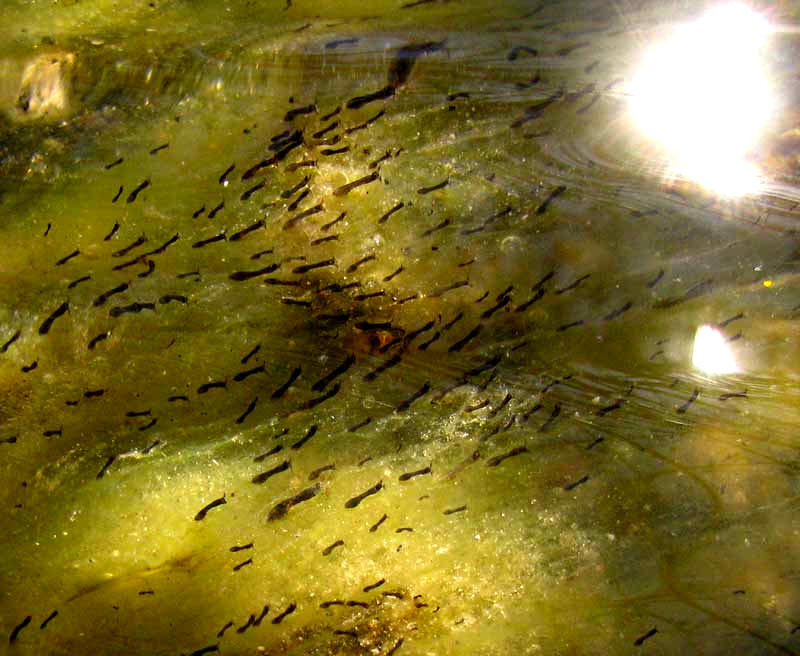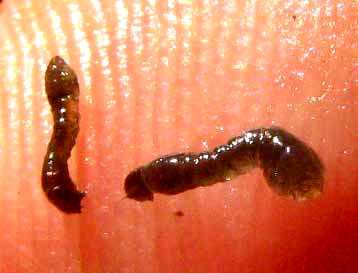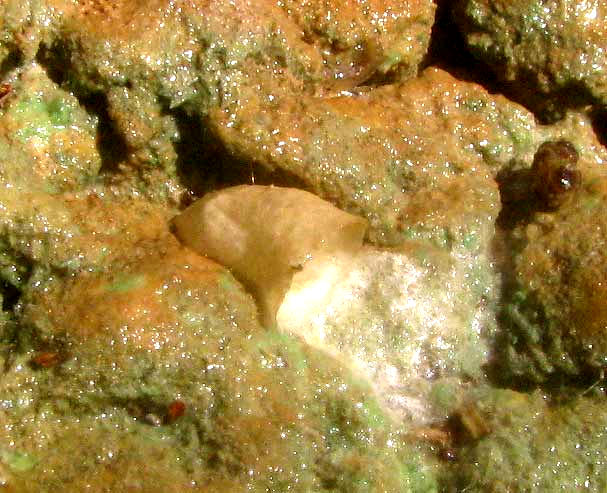Excerpts from Jim Conrad's
Naturalist Newsletter

from the February 16, 2014 Newsletter issued from the Frio Canyon Nature Education Center in the valley of the Dry Frio River in northern Uvalde County, southwestern Texas, on the southern border of the Edwards Plateau; elevation ~1750m (~5750 ft); N29.62°, W99.86°; USA
BLACK FLY LARVAE AT A CULVERT
Even after so many months of drought, water flowed in a clear stream about half an inch deep (13mm) from a corrugated metal culvert where the road dipped into the little Dry Frio River at one of our famous "low-water crossings." A buttonbush shaded the trickling water and algae or cyanobacteria formed a spongy, green carpet over the culvert's outflow lip, as shown above.
 Up close, the greenish carpet was speckled with black, oblong items, like a submerged moss colony issuing black capsules. I'd never seen such a thing so I pinched some "black capsules" from the water, which you can see squirming on my fingertip at the right. About 3/16ths inch long (5mm), they're aquatic insect larvae with curiously big bottoms!
Up close, the greenish carpet was speckled with black, oblong items, like a submerged moss colony issuing black capsules. I'd never seen such a thing so I pinched some "black capsules" from the water, which you can see squirming on my fingertip at the right. About 3/16ths inch long (5mm), they're aquatic insect larvae with curiously big bottoms!
What's missing in that picture is the animation, for though the flow was a mere trickle, in this tiny ecosystem the water's rippling surface sparkled and the black larvae oscillated back and forth almost violently, like small flags in a stiff breeze. Closer up still the individual larvae displayed not only big bottoms but also their segmented bodies and antenna-like appendages on their heads, shown below:

Later that day, on another project I stumbled upon a picture of exactly what's shown in our pictures. It was labeled "Aquatic Black Fly Larvae, Simulium species." Other pictures of aquatic black fly larvae also matched our pictures. A University of Florida webpage on black flies says that black fly larvae live only in well oxygenated, flowing water, and further remarks that "They will be particularly abundant near culverts under roads, attached to plants trailing in the water." Moreover, entomologists have collected black flies of the genus Simulium in Uvalde County.
So, our pictures show aquatic larvae of the black fly genus SIMULIUM, of which several hundred species are known. Knowing the genus, now we can look up what those antenna-like things are on the larvae's heads. It turns out that they're "cephalic fans" used for filtering food such as minute organisms and debris, which is snared by sticky material on the fans. Our pictures show that the fans can be withdrawn. I read that the larvae's mouthparts -- "mandibular brushes" and "labral bristles" -- comb what adheres to the fans into the mouth. The larvae of many black flies also are able to scrape the substrate they're attached to.
The University of Florida sees fit to offer a page on black flies because females of the species, needing protein for their eggs, take blood from a wide range of host species, including cattle, horses, sheep, goats, poultry, other livestock and wild mammals, birds, and humans, depending on the black fly species. And the bites can hurt, and sometimes transfer diseases. The flies cut into the skin, feed on the resulting pool of blood, and inject anticoagulants to keep the blood flowing. The anticoagulants can cause mild to severe allergic reactions in sensitive individuals, and the bites can itch for days. In large enough numbers, black flies can cause anemia in a host.
So, the adults can be disagreeable, but those larvae so busily filtering sparkling water flowing over their undulating green pasture creates such a pretty scene that you just can't help but wish them every success.
from the March 2, 2014 Newsletter issued from the Frio Canyon Nature Education Center in the valley of the Dry Frio River in northern Uvalde County, southwestern Texas, on the southern border of the Edwards Plateau; elevation ~1750m (~5750 ft); N29.62°, W99.86°; USA
SILKEN CONE BENEATH A ROCK
Beneath a flattish, limestone rock mostly submerged beneath fast-flowing water at a tiny rapids in the Dry Frio, something turned up I'd never seen: Between the size of a BB and a small pea, it was ram-horn-shaped and made of something like smooth, cream-colored paper or plastic. The open end of the horn seemed to be sealed inside with a silken lid, and the horn's opening was pointed downstream so that hydrodynamically it offered the least possible resistance to the flowing water. A diminishing carpet of silk issued from the horn's opening across the rock surface. All this can be seen below:

Aquatic spiders don't appear to create such structures. After eliminating that idea, neither volunteer identifier Bea in Ontario nor I had any idea who might have constructed such an elegant and mysterious little object. Bea submitted the picture to BugGuide.Net's identification-needed page. For a whole day there was silence as bug connoisseurs all across the planet scratched their heads, but finally Mark Melton in California commented that certain black flies produce similar cocoons for their aquatic pupae. Pursuing that lead, eventually pictures and drawings were found matching our discovery.
So, I'm fairly sure that our photograph shows the cocoon of a pupa of one of many species of black fly, genus Simulium. Another piece of evidence supporting the theory is that two weeks ago in our February 16th Newsletter {see above} we profiled a population of black fly larvae.
Remember that the formula for insect complete metamorphosis, which is practiced by the Fly Order, the Diptera, is:
egg --> larva --> pupa --> adult
Therefore, earlier, in a similar environment with fast-flowing, well oxygenated water in the Dry Frio, we saw black fly larvae, and now some of those larvae have metamorphosed to pupae. Black fly pupae encase themselves in silken cocoons, or cases, attached to aquatic vegetation or other objects in streams. When a submerged pupa metamorphoses into an adult, it slits through its silken case and floats to the water's surface on a bubble of air. Some species mate as soon as the adults emerge.
What a pleasure to find something new to me, and figure out that thing's secrets!